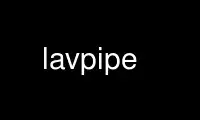
This is the command lavpipe that can be run in the OnWorks free hosting provider using one of our multiple free online workstations such as Ubuntu Online, Fedora Online, Windows online emulator or MAC OS online emulator
PROGRAM:
NAME
lavpipe - creates raw YUV streams from pipe list scripts
SYNOPSIS
lavpipe [-o num] [-n num] pipe-list
DESCRIPTION
lavpipe reads a script file called 'pipe list' that is of a similar structure as the edit
lists that can be fed into lav2yuv. For info about the pipe list format see below.
The pipe list defines several video sources and filters that are combined by lavpipe to
produce a single output YUV stream on stdout (which for example can be compressed and
stored to disk via mpeg2enc(1) or yuv2lav(1)).
OPTIONS
The command line options are used to output a specific part of the resulting video stream.
That means you can tell lavpipe how many frames to skip and how many frames to deliver
from that point on.
-o num This is the frame offset of the output video. The first num frames of the resulting
video simply are neither calculated nor written to stdout. This value defaults to
0.
-n num This is the frame count. If the input files or streams defined in the pipe list
script are long enough, the output will be of exactly num frames length. A value of
0 means that all frames until the last one as defined in the pipe list will be
written out, as long as there's some input (0 is the default).
pipe-list
This is name of the pipe list file that lavpipe will 'execute'. For information
about this file's format see below.
-? Display a synopsis of the command syntax.
EXAMPLES
lavpipe -o 100 -n 25 film.pli
would calculate and output to stdout frames 100 to 124 as defined in film.pli (in
PAL this would be the 5th second of the film).
lavpipe input.pli | yuv2lav -q80 output.avi
would save the movie assembled by lavpipe as a single AVI file.
USAGE
In this section the format of lavpipe's input files the pipe list scripts is explained. If
you need some examples or a more detailed tutorial, please read the mjpegtools(1)
manpage's section about CREATING MOVIE TRANSITIONS. and the file README.lavpipe that
should be included in the distribution. Also feel free to contact us via the mailing list
(see below).
A pipe list contains of two parts: the YUV source list and after this, as many sequence
descriptions as wanted. It always begins with the following two lines:
LAV Pipe List
This is the first line in every pipe list script. It is used as a simple test if
lavpipe really was given a pipe list script and not your PhD thesis as input.
NTSC|PAL
This is the second line in every pipe list and can be either PAL or NTSC, depending
on what video standard you use. I don't remember if this is used at the moment.
Now follows the source list:
num This is the number of input commands. lavpipe will read the next num lines and
interpret them as input stream commands.
command (num times)
This is a valid command line with two variables $o and $n that will be replaced by
lavpipe with the offset and number of frames that the program has to output.
Example:
lav2yuv -o $o -f $n input.avi
Thus, an example source list could look like this:
2
lav2yuv -o $o -f $n scene1.avi
lav2yuv -o $o -f $n scene2.avi
after this you can append as many sequence descriptions as needed. Each of them is built
up as follows:
num The number of frames that this sequence will last.
num The number of inputs that will be used in this sequence. This number must of
course be less than or equal to the number of inputs that are defined above.
idx [ofs] (num times)
These are the indices to the sources that are defined at the beginning of the file
(first source is 0) with an optional frame offset (i.e. sequence starts with frame
number ofs of this input.) - this value defaults to 0. Example:
0 150
command
This is a valid command line to a YUV filter tool that reads num input streams and
writes one output stream, combining its inputs. Optionally, the filter tool can be
given the two $o and $n variables that will be replaced by lavpipe as in the source
commands (see above). For further info read README.lavpipe or the documentation for
the filter programs (if available). An example filter could look like this:
transist.flt -o 0 -O 255 -s $o -n $n -d 50
And if the sequence only has one input that simply should be copied to the output,
you can use a dash instead of a command line:
-
And here's an example for a complete pipe list that implements a transistion from
scene1.avi to scene2.avi
REMOVE THE COMMENTS AFTER The #
LAV Pipe List
PAL
2
lav2yuv -o $o -f $n scene1.avi
lav2yuv -o $o -f $n scene2.avi
50 # first sequence: 50 frames
1 # contains one input:
0 0 # scene1.avi, offset 0
- # simple output
25 # second sequence: 25 frames
2 # contains two inputs:
0 50 # scene1.avi, offset 50
1 # scene2.avi, offset 0
transist.flt -o 0 -O 255 -s $o -n $n -d 50 # transistion
50 # third sequence: 50 frames
1 # contains one input:
1 25 # scene2.avi, offset 25
- # simple output
Use lavpipe online using onworks.net services
